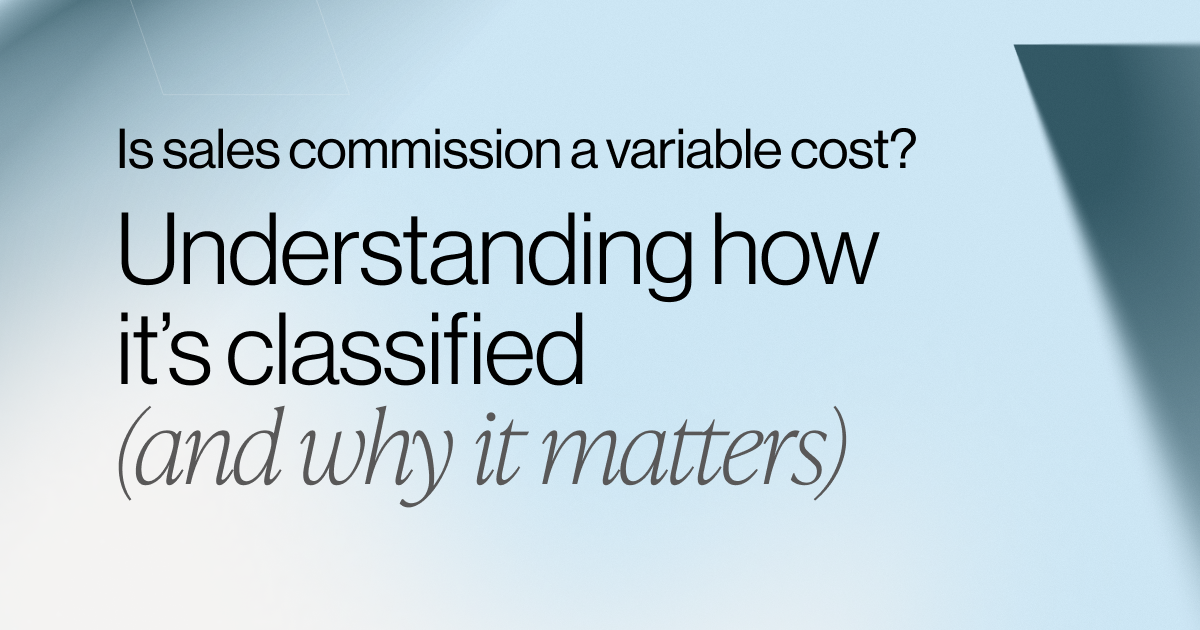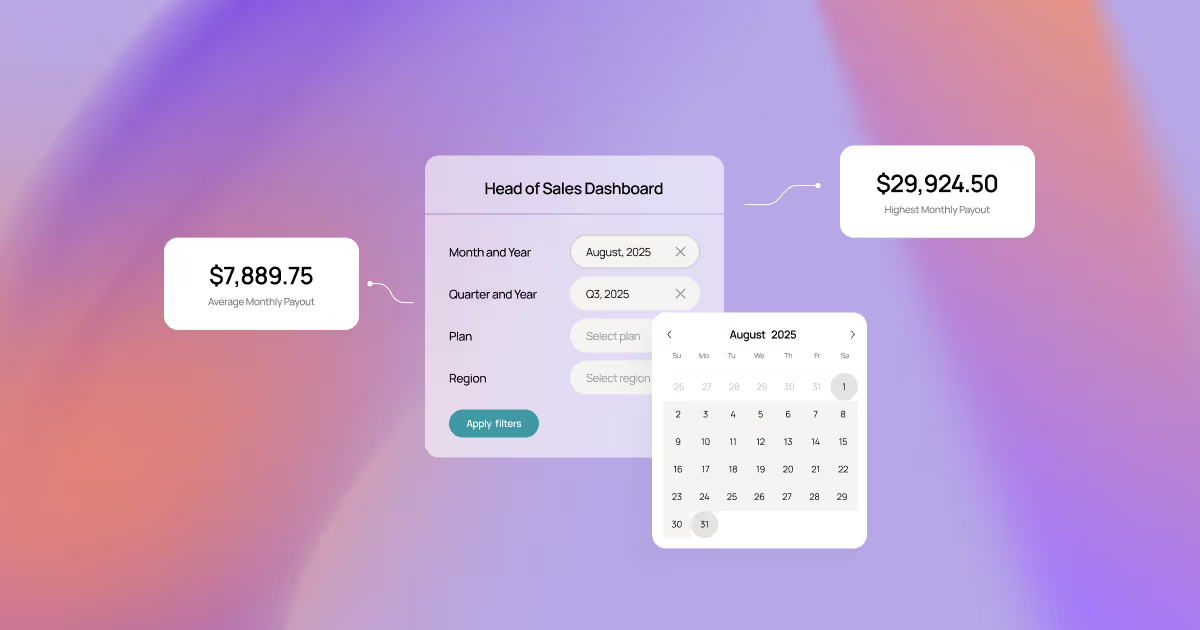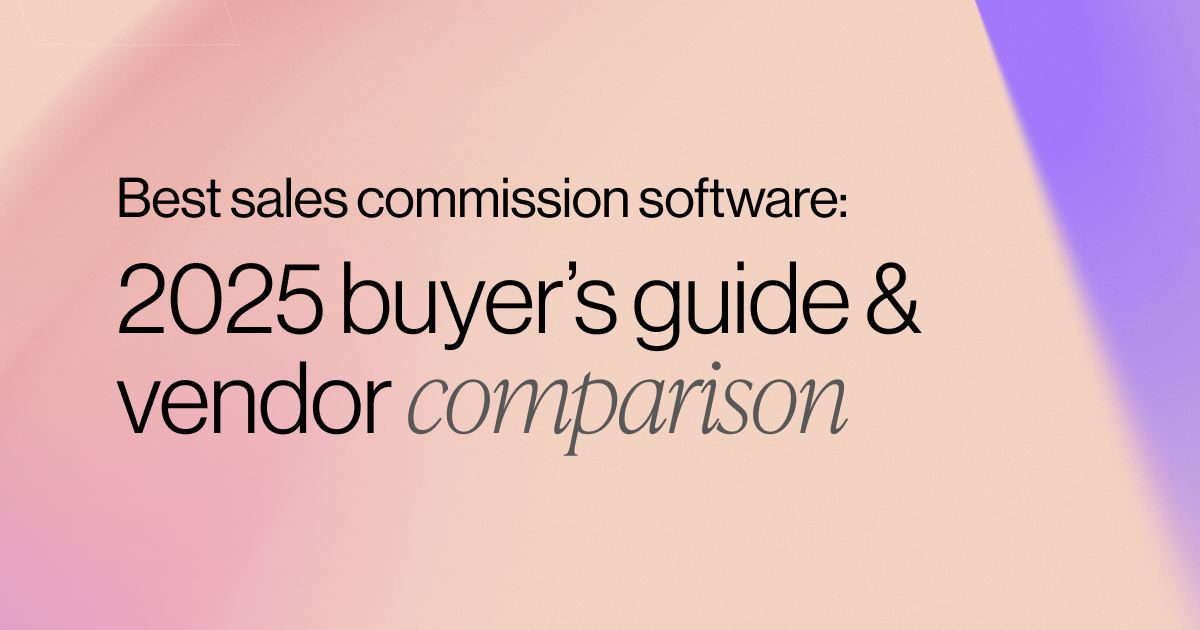How to Build Custom Sales Compensation Dashboards
Running an incentive compensation program is no small task. Money —and the success of your sale organization as a whole— is on the line.
Your sales compensation plan requires a gentle balance of accountability, visibility, and transparency,
To manage a sales compensation plan is to run into a series of challenges. From dealing with time constraints to minimizing errors and reducing cross-functional friction, organizations must ensure they get every detail right.
After all, we're talking about sales reps' hard-earned cash.
Dynamic dashboards for sales compensation plans
The sensitive and critical nature of calculating employee commissions accurately (and quickly) led to the CaptivateIQ platform.
Our founders recognized early on that “everybody wins” if we could help more businesses manage this complex problem with greater ease, automation, and intelligence.
- Sales reps would have greater trust that they are accurately rewarded for their efforts.
- Commission teams would get weeks back in their day-to-day to focus on more significant initiatives.
- Leadership and sales managers would have better visibility and insights into quota attainment across their various incentive plans.
All of the above starts with sound sales compensation dashboards.
This article will define (and show examples of) a sales compensation dashboard, detail why they are so important, discuss some of the “must-have” features, and more.
Let’s start with a definition.
What is a sales compensation dashboard?
A sales compensation dashboard is like a GPS for sales organizations.
This performance dashboard can help track:
- How much money (revenue) your sales team brings in,
- How many deals have closed,
- Profit margins,
- Other crucial sales performance metrics.
A compensation or sales commission dashboard can also give you real-time insights into an individual’s performance against quota, commissions, and other key performance indicators that help evaluate the effectiveness of each rep on the sales team.
Think of them as one-stop shops for sales data. The dashboard typically includes the following:
- Sales goals: The targets that the sales team is expected to meet.
- Sales performance: The actual sales achieved by each team member (and the team as a whole).
- Commissions earned: The amount each salesperson makes due to their sales.
- Sales pipeline: The opportunities currently being pursued by the sales team.
- Customer acquisition costs: The cost of acquiring each new customer.
- Sales quota attainment: How close (or far) to reaching sales quota.
Sales compensation dashboards arm leaders with information that lets them monitor progress towards commissions and other incentives in the compensation program, empowering them to make informed decisions about commission earnings and the overall sales strategy.
In addition, sales reps and managers get real-time views into performance and attainment. This can increase motivation and ensure ongoing visibility and transparency.
All in all, it's an excellent way for teams to visualize results in an easy-to-access format!
Why are sales compensation dashboards important?
Other than visibility and transparency (both huge), compensation dashboards are essential to:
Gain trust and accountability
When compensation dashboards are visible to all in the sales organization (as well as the C-suite), an inherent openness and confidence come along.
There is no hiding when you can see where everyone sits with sales and compensation — in real-time. All are accountable.
I love that it's clear to understand and doesn't confuse me when I look at the commissions for the month. It's great to have a graph view as well as a list of the different opportunities but also insights on the quota attainment and quarterly bonus. — Lucia B., Strategic Account Manager
I love that I can see my compensation calculations up front, and with a relatively easy-to-read breakdown available so I can compare my shadow accounting with what's being reported. Also, it's very easy to escalate/audit concerns to the ops team and have a conversation about what's missing. — Darren S., Account Executive review on G2
Streamline processes
Managing sales commission processes can be time-consuming and full of potential (human) errors.
Sales compensation dashboard help to streamline the entire process saving time and improving accuracy.
Commission teams get weeks back in their day-to-day to focus on more significant initiatives.
Commissions calculations now happen in seconds. We went from spending a few days calculating and sending statements to reps to spending just a few hours on this. — Jeff M., Head of Finance, Harness
Managing commissions is a pain, and it takes time away from other more important tasks. This helped me stop wasting time building my own spreadsheets to track everything. — Jay W., Enterprise Sales
Make better (data-driven) decisions
Sales commission dashboards on their own tell us “here’s what happened” but may not necessarily tell us why.
With a dynamic dashboard, you can apply filters that let you slice and dice the sales datum any way you see fit to get a clear picture behind specific metrics.
For example, suppose you have teams spread across the globe.
In this case, you can create a global dashboard and apply geographical filters to understand each market’s performance without creating multiple reports.

Create alignment with a single source of truth
Sometimes, applying a filter isn’t enough. Instead, you want to see the underlying data to know where this number comes from.
Note: CaptivateIQ allows users to double-click on any data point to easily see the raw, underlying sales data table from that the visual is pulling from.
You can even export this data into a spreadsheet to further apply your Excel Ninja skills.

Increase engagement for the entire team
Ultimately, sales compensation dashboards create a better rep experience.
CaptivateIQ’s custom dashboards give sales reps and managers enhanced visibility into performance — including leaderboards, top performers, and the like.
The best thing about CaptivateIQ is the time it has saved me when calculating commissions. It also has the flexibility for us to report data being used in our calculations thus allowing transparency and confidence in what our sales reps are being paid. — Laura H., Analytics Manager on G2
Use a sales dashboard to monitor and support team performance against business objectives.
Clear performance data will help reps understand their goal performance, take accountability when needed, and seek support proactively.
Guiding principles for a sales compensation dashboard
When you start to create your sales compensation dashboard, keep these "must-have" compensation plan details in mind.
Relevance and alignment
The sales performance metrics and data that you present must align with your overarching business strategy and goals; otherwise, you might generate misleading or unhelpful performance insights and waste valuable time.
Let's think of a real-world example.
Say your sales commission dashboard tracks the total number of calls each salesperson makes. This is only useful if its connected to a business goal or otherwise promotes productivity.
If the sales team's strategic objective is to increase customer satisfaction, then the above performance data won't be helpful.
User-friendliness
A sales dashboard should have a clear, easy-to-use interface with visualizations presented in a logical, appealing, and organized manner.
This helps end users quickly pinpoint key sales performance metrics and trends to take action as needed to improve performance.
Real-time data
Real-time updates for your sale commission dashboard data make it easier to spot sales performance trends and patterns.
Since a major benefit of a dashboard is saving valuable time, I recommend ensuring that the underlying data is up-to-date.
The latest (and greatest) data empowers sales leaders to quickly adjust compensation plans, strategies, and resource allocation.
Customizability
No two companies are exactly alike. When monitoring goal performance, we'll like track progress against a unique set of business goals and sale behavior.
The metrics most important to one organization may be less relevant to another.
Customizable dashboards allow organizations to choose the specific sales metrics and performance insights they want to track and present in the most valuable and relevant way.
Customizable sales commission dashboards can also improve user experience. A user-friendly interface will help reps understand the user's role, and increase motivation to actually use the sales compensation software.
Integrations
Connecting commission data to your existing software can save hours (or even weeks) of unnecessary work.
Integrations also help automate tasks and streamline workflows — which is a huge benefit.
For example, when a deal is closed in a CRM, a sales commission dashboard can automatically calculate appropriate commissions. Talk about a time saver and error reducer!
Integrations can also help “future-proof” the sales compensation dashboard by allowing for the addition of new data sources or systems as the your organization grows and business goals evolve.
CaptivateIQ connects effortlessly to your CRM, ERP, HRIS, data warehouses, and more. Check out how you can access commission data, no matter where it resides, with our data integrations.
Important sales commission metrics
Sales commission metrics track sales teams' performance and determine commission earnings.
Here are a few of the more common specific metrics to follow, and why.
- Sales revenue: The amount of money a sales team brings in through sales. This can determine the overall compensation for the team and individual salespeople.
- Gross margin: The amount of money a company makes on each sale after accounting for the cost of producing or acquiring the goods sold. Think profit margin. This compensation metric is often used to gauge a sales team's profitability.
- Sales activity: This is a sales team's “daily hustle” — the number of sales-related activities by individual and team. Sales behavior activity could include sales calls made, meetings booked, demos given, and follow-up emails sent.
- Sales pipeline: This is how sales leaders track progress on the number and value of different deals in various stages of the sales process. The sales pipeline means managers can better predict potential revenue, use insights to set goals, determine compensation or commission earnings, and make informed decisions to plan for the future. Analyzing pipeline also means sales leaders can identify areas where team performance is struggling, such as lead generation or closing techniques.
- Customer acquisition cost: The amount of money a sales team spends to attract and win new customers – marketing and sales expenses (advertising, promotions, email outreach, various software, etc.). By tracking the customer acquisition cost, sales managers can see how efficient and effective the marketing and sales teams are at attracting new customers. These key metrics help us set goals, improve sales strategies, and determine compensation.
But what is the magic number when it comes to metrics to measure? 1? 100?
Mark Kemp, CaptivateIQ’s VP of Customer Experience, suggests:
Line of sight is key. I’ve seen plans with 20-30 sales metrics, but that high of a number makes it nearly impossible for a sales rep to know where to focus their efforts. So 3 is the magic number. More than three is too complicated. Less than three is not maximizing opportunities for incentive levers.”
Examples of sales compensation dashboards
If you can visualize a better commission dashboard for your sales compensation plan, you can build it.
Those are words we live by at CaptivateIQ.
We believe in a world where there’s no need to download multiple reports from different sources.
No need to paste disparate data into spreadsheets. No need to build charts and pivot tables to attempt to dissect the data.
CaptivateIQ Dashboards give commission admins an easy and powerful way to create custom visualizations using any data set from any commission plan already connected to our platform.
Bonus: If you want to create a different view for reporting needs (i.e., you need total attainment by rep but don’t want to change the source data), you can massage the unified dataset by applying calculations without altering the raw data.
Types of commission data visualizations
There are a lot of opportunities to diversify how your sales compensation software illustrates your data for you.
Some people like a clean number. Some prefer charts. Others like tables.
That’s why these options (and more) are available to help you create that perfect reporting view for your intended audience.

Highlight critical compensation metrics to improve user focus by adding icons and colors.
Need to aggregate the total commission payout from last month?
Use summary cards to quickly show leadership what they’re looking for.

Showcase your data that suits your audience.
Want to show a time series of rep attainment over the last quarter? Or a breakdown of sales revenue by compensation plan by territory
Select from any of these standard charts to lay out your data in a straightforward and easy-to-understand way.
- Line
- Bar
- Combo (Line + Bar)
- Area
- Row
- Waterfall
- Scatter
- Pie
- Funnel
- Trend
Turn your compensation program from an administrative task to a strategic advantage
Sales commissions make up one of the most significant line items on a company’s P&L.
Yet so many companies are managing this complex process using outdated software or manually in spreadsheets. No wonder commission teams spend weeks each month administering payouts instead of improving their compensation strategy.
With so much time spent administering commissions, few teams have the time to look under the hood to ask themselves, “are we incentivizing our reps correctly?” To answer that question, commission admins must spend even more time downloading different reports, running more calculations, and sharing data with leadership to prove their point. And who’s got time for that?
CaptivateIQ’s goal is to automate as much of the commissions process as possible so that revops, finance, accounting, and sales leaders can have more time to process what’s most important.
Want to explore how CaptivateIQ’s Reporting suite can help you drive informed decision-making for your business? Take a product tour!
.svg)








